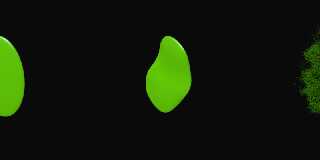|
 |
On 9/4/23 04:28, And wrote:
> William F Pokorny <ano### [at] anonymous org> wrote:
>> Using several povr features, tried my hand at rendering an isosurface
>> cloud this afternoon. Like media, it takes some twiddling. Using +am1
>> +a0.0 +r9 to force a large amount of sampling, one light for the sun and
>> radiosity it took about 30 minutes on my two core, four thread i3.
>>
>> How many shapes - bazillions :-).
>>
>> Bill P.
>
> I browse here at the first time.
> It is good, how do you render such an image with a "surface"?
>
Hi. I've attached an image and will paste in the POV-Ray (povr) scene
file used to create the sub-images. Your question gives me a chance to
show povr's 'pattern_modifiers' feature too!
On the left is the f_sphere() modified, but still with no turbulence.
The center image applied a gentle warp { turbulence ...}.
Your question is answered with the image on the right where a violent
warp turbulence was applied; one which blows the isosurface apart.
The max gradient jumps way up - but we'd ignore it (povr's isosurface
'report off') in any more complex scene. The max_gradient you use
becomes a particle sampling setting. For a cloud, or bush, or tree
foliage you want the isosurface to act like a collection of particles.
Bill P.
//-------------------------------- isoCloudsExmpl.pov
#version unofficial 3.8; // povr
#if (file_exists("version.inc"))
#include "version.inc"
#end
#if (!defined(Fork_povr))
#error "This POV-Ray SDL code requires the povr fork."
#end
global_settings { assumed_gamma 1 }
#declare Grey10 = srgb <0.1,0.1,0.1>;
background { Grey10*0.3 }
#declare Camera00 = camera {
perspective
location <3,3,-3.001>*0.7
sky y
angle 35
right x*(image_width/image_height)
look_at <0,0,0>
}
#declare White = srgb <1,1,1>;
#declare Light00 = light_source { <50,150,-250>, White }
// The focus is just below. It shows the use of the
// pattern_modifiers keyword as a way to use the spacial
// modifiers, POV-Ray users know, to manipulate inbuilt functions.
#include "functions.inc"
// Function f_sphere defined in functions.inc
// Bang on a f_sphere() function
#declare Black = srgb <0,0,0>;
#declare PigMods00 = pigment {
color Black
rotate 45*x
scale <1.3,2.3,0.2>
rotate -15*y
#if (0)
warp { turbulence <0.2,0.2,0.2>
octaves 3 omega 0.37 lambda 1.75 }
#elseif (1)
warp { turbulence <0.2,0.2,0.2>
octaves 7 omega 0.87 lambda 7.75 }
#end
}
#declare FnPigMods00 = function {
pattern_modifiers { PigMods00 }
}
#declare Fn00 = function (x,y,z) {
f_sphere(FnPigMods00(x,y,z).x,
FnPigMods00(x,y,z).y,
FnPigMods00(x,y,z).z,0.3)
}
#declare ChartreuseGreen = srgb <0.50196,1,0.05>;
#declare Isosurface00 = isosurface {
function { Fn00(x,y,z) }
contained_by { box { -1.0,1.0 } }
report on
threshold 0
accuracy 0.0005
max_gradient 17.0
max_trace 1
pigment { color ChartreuseGreen }
}
//--- scene ---
camera { Camera00 }
light_source { Light00 }
object { Isosurface00 finish { phong 0.6 phong_size 20} } org> wrote:
>> Using several povr features, tried my hand at rendering an isosurface
>> cloud this afternoon. Like media, it takes some twiddling. Using +am1
>> +a0.0 +r9 to force a large amount of sampling, one light for the sun and
>> radiosity it took about 30 minutes on my two core, four thread i3.
>>
>> How many shapes - bazillions :-).
>>
>> Bill P.
>
> I browse here at the first time.
> It is good, how do you render such an image with a "surface"?
>
Hi. I've attached an image and will paste in the POV-Ray (povr) scene
file used to create the sub-images. Your question gives me a chance to
show povr's 'pattern_modifiers' feature too!
On the left is the f_sphere() modified, but still with no turbulence.
The center image applied a gentle warp { turbulence ...}.
Your question is answered with the image on the right where a violent
warp turbulence was applied; one which blows the isosurface apart.
The max gradient jumps way up - but we'd ignore it (povr's isosurface
'report off') in any more complex scene. The max_gradient you use
becomes a particle sampling setting. For a cloud, or bush, or tree
foliage you want the isosurface to act like a collection of particles.
Bill P.
//-------------------------------- isoCloudsExmpl.pov
#version unofficial 3.8; // povr
#if (file_exists("version.inc"))
#include "version.inc"
#end
#if (!defined(Fork_povr))
#error "This POV-Ray SDL code requires the povr fork."
#end
global_settings { assumed_gamma 1 }
#declare Grey10 = srgb <0.1,0.1,0.1>;
background { Grey10*0.3 }
#declare Camera00 = camera {
perspective
location <3,3,-3.001>*0.7
sky y
angle 35
right x*(image_width/image_height)
look_at <0,0,0>
}
#declare White = srgb <1,1,1>;
#declare Light00 = light_source { <50,150,-250>, White }
// The focus is just below. It shows the use of the
// pattern_modifiers keyword as a way to use the spacial
// modifiers, POV-Ray users know, to manipulate inbuilt functions.
#include "functions.inc"
// Function f_sphere defined in functions.inc
// Bang on a f_sphere() function
#declare Black = srgb <0,0,0>;
#declare PigMods00 = pigment {
color Black
rotate 45*x
scale <1.3,2.3,0.2>
rotate -15*y
#if (0)
warp { turbulence <0.2,0.2,0.2>
octaves 3 omega 0.37 lambda 1.75 }
#elseif (1)
warp { turbulence <0.2,0.2,0.2>
octaves 7 omega 0.87 lambda 7.75 }
#end
}
#declare FnPigMods00 = function {
pattern_modifiers { PigMods00 }
}
#declare Fn00 = function (x,y,z) {
f_sphere(FnPigMods00(x,y,z).x,
FnPigMods00(x,y,z).y,
FnPigMods00(x,y,z).z,0.3)
}
#declare ChartreuseGreen = srgb <0.50196,1,0.05>;
#declare Isosurface00 = isosurface {
function { Fn00(x,y,z) }
contained_by { box { -1.0,1.0 } }
report on
threshold 0
accuracy 0.0005
max_gradient 17.0
max_trace 1
pigment { color ChartreuseGreen }
}
//--- scene ---
camera { Camera00 }
light_source { Light00 }
object { Isosurface00 finish { phong 0.6 phong_size 20} }
Post a reply to this message
Attachments:
Download 'isocloudsexmpl.png' (81 KB)
Preview of image 'isocloudsexmpl.png'

|
 |




![]()